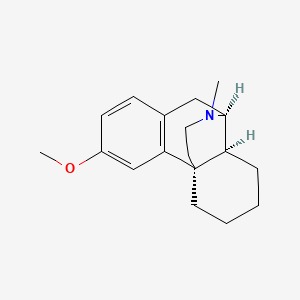|
Name: Desomorphine
Type: Opioid
AKA: Krokodil

|
|
II. Natural Derivative
Synthetic substance, no natural derivative
 |
|
III. Chemical Profile (IUPAC name)

|
|
IV. History
Desomorphine, a potent synthetic opioid, was developed in the 1930s. It gained notoriety in the 21st century as a street drug known as 'krokodil' due to its severe and destructive effects on users' health. Historically, it was used medically but fell out of favor due to its high abuse potential and harmful side effects. Its use in the 21st century has been associated with severe tissue damage and addiction issues.

|
|
V. Legal Information
Desomorphine is a potent synthetic opioid with high abuse potential. It is controlled under opioid laws due to its risk of addiction and misuse. [Source: UNODC].
US Federal Schedule - I
Schedule I drugs, substances, or chemicals are defined as drugs with no currently accepted medical use and a high potential for abuse. Some examples of Schedule I drugs are: heroin, lysergic acid diethylamide (LSD), marijuana (cannabis), 3,4-methylenedioxymethamphetamine (ecstasy), methaqualone, and peyote.
Key US Federal Policies:
Controlled Substances Act. Public Law: Public Law 91-513 (text can be found on GovInfo) (https://www.dea.gov/drug-information/csa). Date enacted: October 27, 1970.
|
|
VI. Physical Effects
Desomorphine is a powerful opioid with effects similar to morphine. It causes sedation, respiratory depression, and constricted pupils. Short-term use provides strong pain relief, but long-term use can lead to addiction, severe health complications, and cardiovascular issues. Overdose risks include respiratory depression and potential death. Safe use requires careful dosing and medical supervision. Recent research highlights its potency and the significant risks associated with its use.  |
|
VII. Psychological Effects
Desomorphine is a potent synthetic opioid producing intense euphoria, sedation, and analgesia. Immediate psychological impacts include drowsiness, mood elevation, and cognitive impairment. Long-term use can lead to addiction, tolerance, and severe withdrawal symptoms. Chronic use is associated with depression, anxiety, and cognitive decline. Recent research emphasizes the high abuse potential and neurotoxicity of opioids.
 |
|
VIII. Culture
Desomorphine, also known as krokodil, is a synthetic opioid known for its potent effects and severe side effects. It has no historical lore but gained notoriety in the 21st century, particularly in Russia, for its association with harmful recreational use. Proponents discuss its efficacy in pain relief, while opponents focus on its dangerous effects and widespread health issues.
 |
